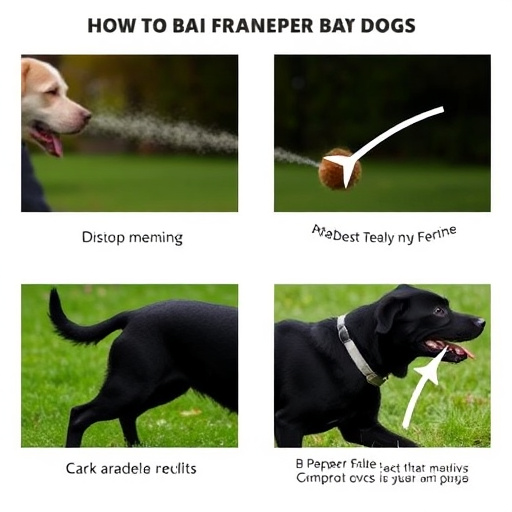Canine repellents have evolved with active ingredients like capsaicin, citronella, and synthetic analogs. Modern formulations prioritize safety, environmental friendliness, and non-toxicity. Efficacy varies by species, weather, and formulation, requiring regular reapplication. Safety features in canine repellent are crucial, with natural ingredients used sparingly and repellents tested for human and animal safety. Compact spray designs offer portability, while certified products ensure regulatory compliance and child-resistant packaging.
“Discover an effective solution to keep your spaces pet-friendly with our review of the Mace Animal Repellent Compact Spray. As pet owners, understanding canine repellents is key to maintaining a safe and comfortable environment. This guide explores vital aspects, from the efficacy of key ingredients to safety features in canine repellents, including potential irritants and environmental considerations. We also delve into the compact spray design’s benefits, offering a practical, portable option for easy application.”
- Understanding Canine Repellents: Key Ingredients and Efficacy
- Safety Considerations: Irritants, Allergens, and Environmental Impact
- Compact Spray Design: Portability, Application Ease, and User Experience
- Regulatory Compliance and Certification for Dog Repellents
Understanding Canine Repellents: Key Ingredients and Efficacy
Canine repellents, designed to ward off animals like dogs, cats, and wildlife, have evolved significantly over time. These products often contain a blend of key ingredients aimed at creating an unpleasant sensory experience for target animals. Common active ingredients include capsaicin (from chili peppers), citronella, and synthetic analogs that mimic natural repellents. Safety features in canine repellent are paramount; many modern formulas are designed to be environmentally friendly and non-toxic to humans and pets when used as directed.
The efficacy of these repellents varies based on factors such as the species targeted, weather conditions, and the specific formulation. For instance, capsaicin is highly effective against dogs but may not deter felines. Regular reapplication is often necessary due to weathering and evaporation, particularly in outdoor settings. Understanding these nuances ensures users can select the most suitable canine repellent for their needs, balancing safety features with proven efficacy.
Safety Considerations: Irritants, Allergens, and Environmental Impact
When using any animal repellent, including those designed for canine deterrence, safety should be a top priority. While many repellents on the market are effective, some may contain irritants or allergens that could cause harm to both pets and people, especially when not used properly. It’s crucial to check the product label for safety instructions and warnings before application.
Many canine repellents utilize natural ingredients like capsaicin (the active compound in chili peppers) or essential oils known for their pungent aromas. While these substances are generally safe for humans and pets when used sparingly, prolonged exposure or ingestion could lead to skin irritation or allergic reactions. Additionally, the environmental impact of these chemicals should be considered, as some can disrupt local ecosystems if not disposed of correctly. Look for repellents that prioritize safety features in canine repellent formulations, ensuring they meet industry standards and are tested for both human and animal safety.
Compact Spray Design: Portability, Application Ease, and User Experience
The compact spray design of a mace animal repellent is a significant advantage, offering unparalleled portability and ease of application. Its small size allows users to carry it conveniently in pockets or bags, ensuring easy access during outdoor activities. This handy feature is particularly appealing for hikers, campers, and anyone venturing into areas prone to wildlife encounters. With just a simple flip of the nozzle, users can spray the repellent directly onto potential threats, providing an effective barrier without any mess or hassle.
The user experience is further enhanced by safety features incorporated into the canister design. Many models employ child-resistant mechanisms to prevent accidental activation, ensuring that only the intended user can operate it. Additionally, some versions include protective shields or caps that secure the nozzle, minimizing the risk of accidental spraying and maintaining the integrity of the product during transport. These thoughtful touches contribute to a positive overall experience for users who value convenience, safety, and peace of mind while enjoying the outdoors.
Regulatory Compliance and Certification for Dog Repellents
When it comes to dog repellents, especially those designed as compact sprays, regulatory compliance and certification are paramount to ensure both safety and effectiveness. Repellents must adhere to stringent standards set by governing bodies to guarantee they do not pose harm to dogs or other animals. These regulations encompass ingredient safety, packaging integrity, and label accuracy, among other factors.
Safety features in canine repellents include the use of approved active ingredients that are non-toxic and safe for application on pets. Reputable manufacturers also incorporate child-resistant packaging to prevent accidental misuse. Certifications from recognized organizations, such as those that validate product safety and quality, offer assurance to consumers. Always opt for certified products to ensure peace of mind and the well-being of your canine companion.
When it comes to choosing an effective and safe canine repellent, the Mace Animal Repellent Compact Spray stands out. Its innovative compact design offers unparalleled portability and ease of application, ensuring users can protect themselves and their pets with convenience. Key ingredients and regulatory compliance play a vital role in its efficacy, addressing potential irritants and allergens while adhering to strict safety features in canine repellents. By combining these factors, this repellent provides a reliable solution for those seeking to deter unwanted animal encounters, all without compromising on user-friendliness or environmental considerations.
